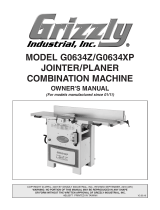
ENGLISH en
13
Original Instructions
We hereby declare that these bevellers, identified
by type and serial number *1), meet all relevant
requirements of directives *2) and standards *3).
Technical documents for *4) - see page 4.
For UK only:
We as manufacturer and authorized person to
compile the technical file, see *4) on page 4,
hereby declare under sole responsibility that these
bevellers, identified by type and serial number *1)
on page 3, fulfill all relevant provisions of following
UK Regulations S.I. 2016/1091, S.I. 2008/1597, S.I.
2012/3032 and Designated Standards EN 60745-
1:2009+A11:2010, EN ISO 12100:2010, EN IEC
63000:2018
The beveller is intended for the milling of edges of
steel, stainless steel, aluminium and aluminium
alloys in the professional sector.
For processing aluminium, aluminium alloys and
stainless steel, a suitable lubricant (item no.:
6.23443) must be used.
This lubricant is also recommended when
processing steel as it extends the tool life and the
machine glides more easily over the workpiece.
The user bears sole responsibility for any damage
caused by inappropriate use.
Generally accepted accident prevention
regulations and the enclosed safety information
must be observed.
For your own protection and for the
protection of your power tool, pay
attention to all parts of the text that are
marked with this symbol!
WARNING – Reading the operating
instructions will reduce the risk of injury.
WARNING Read all safety warnings and
instructions. Failure to follow all safety
warnings and instructions may result in electric
shock, fire and/or serious injury.
Keep all safety instructions and information for
future reference.
Pass on your power tool only together
with these documents.
a) Do not use accessories that are not
specifically designed and recommended for
this power tool by the manufacturer. Just
because the accessory can be attached to your
power tool, it does not assure safe operation.
b) Do not use damaged power tools. Before
use, check the indexable inserts for chipping,
cracks or signs of severe wear and tear. If a
power tool or accessory is dropped, inspect for
damage or install an undamaged accessory.
c) Wear personal protective equipment. Use a
face shield, safety goggles or safety goggles
depending on the application. As appropriate,
wear a dust mask, hearing protectors, gloves
and a workshop apron capable of stopping
small abrasive or workpiece fragments. The eye
protection must be capable of stopping flying debris
generated by various operations. The dust mask or
respirator must be capable of filtering particles
generated by your operation. Prolonged exposure
to high intensity noise may cause hearing loss.
d) Keep bystanders a safe distance away from
work area. Anyone entering the work area must
wear personal protective equipment. Fragments
of a workpiece or broken accessory may fly away
and cause injury beyond the immediate area of
operation.
e) Always hold the tool firmly in your hands
during the start-up. The reaction torque of the
motor as it accelerates to full speed can cause the
tool to twist.
f) Use clamps or another practical way to
secure and support the workpiece to a staple
plattform. Holding the work by your hand or
against the body leaves it unstable and may lead to
loss of control.
g) Never lay the power tool down until the
accessory has come to a complete stop. The
rotating accessory may grab the surface and pull
the power tool out of your control.
h) Do not run the power tool while carrying it at
your side. Accidental contact with the rotating
accessory could snag your clothing, pulling the
accessory into your body.
i) Regularly clean the power tool’s air vents. The
motor’s fan will draw the dust inside the housing and
excessive accumulation of powdered metal may
cause electrical hazards.
j) Do not operate the power tool near flammable
materials. Sparks and hot chips can ignite these
materials.
k) Do not use accessories that require liquid
coolants. Using water or other liquid coolants may
result in electrocution or shock.
4.1 Kickback and related warnings
Kickback is the sudden response to an accessory
pinching or jamming while rotating. Pinching or
snagging causes rapid stalling of the rotating
accessory. This causes the uncontrolled power tool
to be forced in the direction opposite of the
accessory’s rotation at the point of the binding.
For example, if an indexable insert is snagged or
pinched by the workpiece, the edge of the insert that
is entering into the pinch point can dig into the
surface of the material causing the insert to climb
1. Declaration of Conformity
2. Specified Use
3. General Safety Instructions
4. Special Safety Instructions












